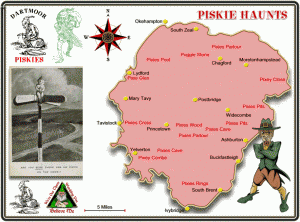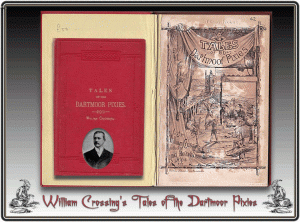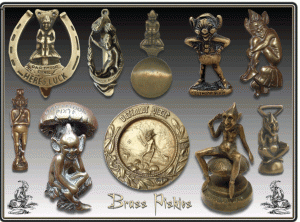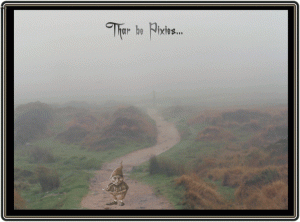
” Thar be piskies up to Dartmoor
And ‘tidn’t no good you say there baint
I’ve felt um grauping at my heart
I’ve heard their voices calling faint“.
For the rest of the verse see – HERE.
Why is a grown man writing about fictitious piskies you may well ask? A question I have asked myself but having read William Crossing’s book – ‘Tales of the Dartmoor Pixies’ I have changed my mind. On the first page of his book he remarks:
“Among the superstitious bygone times which still linger on Dartmoor, the ideas regarding the pixies are undoubtedly the most interesting and romantic. Although the faith of the peasantry in the ability of these ‘little people’ to exercise control over their domestic arrangements is less firm than yore, yet a notion still prevails that ill-luck will certainly overtake the hapless wight who is so unfortunate as to offend any of these diminutive elves.” p.1.
Those words were written only 126 years ago by one of the most eminent Dartmoor writers, so although a very ‘tongue in cheek’ subject it was clearly one that was held very strongly in the hearts of the moorfolk. Perhaps the elusive piskie does not only dwell in the minds of the old folk? Drive past Pixieland on a summer’s day and see all the visitors clutching their ‘Lucky Dartmoor Piskie’ memorabilia. So just maybe it’s possible that the belief in the ‘little people’ still lingers deep down in our psyche today or else why would they buy such things? Ever since visitors began to visit Dartmoor the local shopkeepers soon realised that maybe there was some money to be made out of the piskie tradition. It did not take too long for a whole gamut of piskie related souvenirs to appear all promising to bring good luck to the purchasers. Today many of these early momentoes are highly collectable and in some cases fairly valuable as a quick perusal on Ebay will testify (see phot below). As I write this my desk is surrounded by old brass Dartmoor Piskie-ware which at one time I collected, until I got brasses off with polishing them every few weeks. There are a pair of candlesticks, a letter knife, a bottle opener, a door knocker, a shoe horn, a pin tray, various horse brasses, an ink well, several brass piskies and a tiny tankard. Clearly many of these would be of little use today but at one time they would have been. One must admit each and everyone one depicts a grotesque looking figure that would hardly portray a kind and benevolent creature – more like a malevolent creature. But the big question is why did I collect them? Was it for a hobby or was it because I was hoping for them to bring good luck?
But where does the belief in the little people originate from ? Clearly the stories and superstitions have been handed down through the centuries but from where did they originate and what evidence is to be found today? In the search for the elusive piskies it would be prudent to classify piskies in a broader sense. Firstly, piskies are not only found on Dartmoor but also in the rest of Devonshire, in Cornwall they are commonly known as pisgies, in Somerset they are pixies and in Dorset pexies. It has been suggested that in early times they were all known as fairies but for some reason in the West Country they separated off into their own entities.
The lineage of the piskies may possibly lead back to the mythical trickster known as Puck which was a character who appeared in William Shakespeare’s Midsummer’s Night Dream. As a character Puck was said to be very clever and mischievous elf who was renown for playing tricks on people. Puck also appears in the poem of ‘Peirs the Ploughman’ which was written in the 1300s by William Langland in this poem he refers to Pouke Hall as being hell and a place where Puck resides. The meaning of the Old English word Pouke refers to either the Devil, demon or evil spirit so it does not take a lot of imagination to see from whence the name Puck came. Puck alias the Devil can be found all around the world, in Wales he is known a Pwca, in Ireland as Pooka, in Old Norse as Puki, in Swedish as Puke, in Denmark as Puge and so on and so forth. So leading on from here, in the West Country the name Puck changed from a singular name to a plural one – Pucksey, this then lead to regional variations which on Dartmoor became the collective term – Piskies.
There are many theories as to how the belief in piskies came about. One being that they are pagan spirits who because of their beliefs were unable to enter the Kingdom of Heaven. This may then suggest that this idea was one invented by early Christians used to discourage people from worshipping their old pagan gods. One early Christian story tells of how after being thrown out of the Garden of Eden, Eve was bathing her many children when God announced that he would be visiting her. Because she had so many the task was not finished by the time he arrived so she only took the clean children to meet him. Once assembled God asked Eve if this was all of her brood to which she replies it surely was. Knowing only full well that it was not her entire family God was none to happy at her blatant lie. As a punishment he declared; “let those unseen remain unseen,” and from that time onwards all her children who had not been bathed became invisible to the human eye and banished to roam the earth for ever as Fairies who later became Piskies. Another Christian fallacy that was spread around was that the Piskies were the souls of dead babies who had died before being baptised. Clearly this was supposed to scare people into having their children baptised into the faith.
An alternative suggestion has been that when in Britain the various Roman and Saxon invasions took place the invaders came across the indigenous Celtic people. Supposedly in comparison these were a much smaller race and so when confronted with the more statuesque invaders they fled to the hills and lived in the woods and caves. This then led to the later belief that the ‘little people’ who lived in these remote and secluded locations became the latter-day piskies?
There are numerous references to the piskies and Puck to be found in Dartmoor place-names as can be seen from the map above. In the case of Puck there is the Puggie or Puckie Stone, clearly a derivative from the Old English word Pouke. As far as the name Pixie goes there is; Pixeycombe, Pixey Well, Pixie Glen, Pixies Cave (two of those), Pixies Cross, Pixies Holt, Pixies House, Pixies Parlour (two of them), Pixies Pits, Pixies Pool (two of them), Pixies Rings and Pixies Wood to name but a few. On Dartmoor the bog cotton plant (eriphorum) is also known as Pixie Grass and can be found on the margins of bogs and mires. It was into these that piskies were known to mischievously lead unwary travellers and in some cases they would never be seen again. Quite often on Dartmoor you can come across a delightful bright red cup-shaped lichen growing on the rocks called Cladonia coccifera which due to its colour and shape is locally known as Piskie Cups. It was said that the tiny cups were used by the piskies as drinking vessels at their nighttime revels. There can be found on the moor a mysterious opaque jelly-like substance whose origin attracts several theories, one rather modern tongue-in-cheek idea being that it’s piskie snot or alternatively Star Jelly? There is even a theory that the famous 1933 Disney tale about ‘The Three Little Pigs’ being adapted from a Dartmoor piskie story of ‘The Fox and the Piskies‘ first recorded in 1853.
Traditionally the Dartmoor piskies are regarded in general as being amiable and helpful to the moor-folk. That is provided that any work or favours they do is duly rewarded and under no circumstanced must they be; cheated, spied upon, slandered or stolen from. To keep on their good side people would leave small dishes of cream outside their houses at night and in some cases small plates of food. It was said as long as one fed them they would view favourably upon the household and help when needed in times of trouble. On the other hand should anyone ever cause them offence then their retribution would be swift and drastic. They would be known to steal babies, at night ride horses to the point of exhaustion, spoil any milk, cream and cheese during its manufacture, pinch people during their sleep and generally cause chaos and mayhem. Probably one of the most feared mischievous practice the piskies had was the ability to totally confuse travellers so much that they would wander around not knowing where they were or what they were doing. There are tales of folk aimlessly wandering around all night until in the morning they found themselves miles away from where they were going. This phenomena is locally known as being Piskie Led and believe it or not there still are reports of this happening today and of visitors being concerned about it happening to them.
“They have flown,
Beautiful fictions of our fathers! wove
In superstitions web, when time was young,
And fondly loved and cherished, they have flown
Before the wand of science, hills and vales,
Mountains and moor of Devon, ye have lost
The enchantments, the delights, the visions all,
The elfin visions that so blessed the night
In the old days romantic.”
So there in a nutshell you have a brief outline of the Dartmoor Piskies, make no mistake there are still people who firmly belief in their existence today and who, in an unguarded moment admit to seeing them. It is interesting to note that many of the human encounters with piskies have occurred whilst people, usually men, are returning home after a session down the local inn and a few cups of cider? It has been known for men on returning home late after a good session using the excuse of being Piskie led to avoid the impending shock and awe that was about to come from an irate wife. Sadly this in the majority of cases no loner works – if it ever did? Could belief of Piskies or call them what you like be another manifestation of the human need, like all other religions to believe in something? It seems that this need is to give thanks for good fortune, blame for mis-fortune and be something to appeal to in time of trouble as opposed to taking personal responsibility for any of life’s events?
To read more of their many exploits simply visit the Legendary Dartmoor ‘Tales‘ category where many of the piskie tales and exploits can be found.
 Legendary Dartmoor The many aspects past and present of Dartmoor
Legendary Dartmoor The many aspects past and present of Dartmoor





Thank you for the article it was very interesting. I recently went through some of my father’s boxes and found 10 Dartmoor Pixie items. It looks like 5 various bottle openers, two bells a round teaspoon, some kind of a small brush it appears be made out of horsehair and then a small dust pan shaped thing. My question is should I leave them as is very tarnished or try to shine them up with some kind of brass cleaner before selling them
Definitely leave them as they are, if the new buyers want to polish them then it’s their choice.
Hello there. Are you at all familiar with a legend allegedly from your region known as the Kuri? I’ve heard stories about it, which amount to as follows; person walking the moors finds a dead body, which is where a Kuri, a kind of malevolent goblin, lives. The Kuri latches onto the person, begins whispering in their ear and tormenting them to go back to the moors, and when they do, they die and are dragged off to hell. Can you tell me if this is authentic or not?
Sorry, never come across this one.
Hello, I have a brass lucky lands end piskie that my mum gave me around 30 years ago, were these made in Cornwall & have they stopped making them now, I really like them & have had it on my keys since I got it.
They don’t seem to sell these anymore, do you know when they stopped making these.
Chris